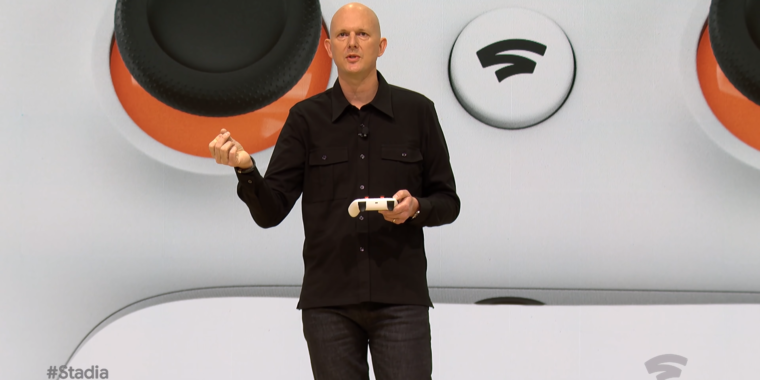-
Google’s Phil Harrison (you may remember him from his days at Sony).
-
The YouTube-to-Stadia interface, as shown at GDC.
-
Specs for Google’s Stadia data centers.
-
How many screens can you play Assassin’s Creed Odyssey on?
-
Stadia on a laptop.
-
Stadia on a smartphone.
-
Stadia on, well, another system.
-
The logo for Google’s new gaming service.
-
Google CEO Sundar Pichai appears at his company’s GDC keynote presentation at GDC 2019.
Google -
“Everyone” is a pretty big potential market.
-
Promises of crazy-high performance for the upcoming Doom Eternal on Google Stadia.
-
A hint at how “multi-GPU” options will boost performance and graphical options.
-
Big promise there, Google.
-
Great news.
Last month, when Google revealed its upcoming Stadia streaming gaming platform, it left open the major question of precisely how Google and game developers would make money from these games running on remote servers. In an on-stage discussion at LA’s GamesBeat Summit this week, though, Google’s Phil Harrison mentioned that “our platform at a fundamental level has been architected to support a very wide variety of what people call ‘monetization options.’ Everything from purchase to transaction to subscription.”
That’s not quite a direct confirmation that all those different options will be available to developers on Stadia. All Harrison would reveal is that “there is no technical limitation on how we have architected the platform to support a variety of business models.” (Emphasis ours.). But that architecture would be a very odd thing for Harrison to bring up if, say, Google was planning to impose a one-size-fits-all subscription on Stadia users.
In discussing Stadia, Harrison has put a lot of focus on how the platform makes it easy for players to share a game through a link in a text message, for instance, or by letting people instantly jump in to an instance of a game they’re watching on YouTube at a specific point on the video. This form of game discovery could “change the way game value is perceived by players,” Harrison said, by removing the “retail store pressure” and limited “outward facing” selection of brick-and-mortar and digital storefronts. “When a game is a link, the Internet is your store,” he said. “That means we can change the perceived value of games.”
That kind of “frictionless” discovery of new games gets a bit more frictional, though, if players have to buy a complete game outright every time they click a Stadia link. All-you-can-play subscriptions, free-to-play ad-supported games, and timed trials could all serve as ways to lessen that friction, and it sounds like all those options and more could work on Stadia.
Harrison says Google will provide more details of Stadia’s business plan “in the summer,” talking “about how gamers will be able to buy and get access to games” at the same time “we talk about the games themselves” that will be available on the platform. That first wave of Stadia titles, he said, will be focused on attracting “a gamer type familiar with AAA games… familiar games and game types.” After that, he envisions “concentric rings of games” that entice a wider audience “to get to the significantly greater scale we aspire to.”
The long haul
Harrison remains confident that streaming game distribution will revolutionize the business of gaming, especially as broadband infrastructure continues to improve worldwide. He noted that the EU has put access to the Internet on the level of a human right. “I don’t think they’ve said access to a high-end gaming PC is considered a human right,” he quipped, as a way of pointing out Stadia’s lower barriers to entry.
Harrison speaks at the GamesBeat Summit in LA (section starts around the 56:30 mark)
At the same time, though, Harrison warns that the switch to streaming gaming “is not going to happen overnight. It’s not going to be a switch that we flip and suddenly we’re all in this utopia of cloud-based gaming. It is going to take a while to get to the scale we think we can get to.”
Part of that transition will be developers getting used to having the power of Google’s cloud infrastructure, Harrison said. For decades, game developers have had to be “device centric,” Harrison pointed out, designing games for specific and limited home hardware specifications. “With cloud gaming, particularly the idea of compute being sharable across multiple CPUs in a data center, now this transition to gaming being data-centric is going to a really fundamental shift,” he said.
The developers who are devoted to taking advantage of this will be able to implement everything from “distributed physics” to “complex multiplayer going from hundreds to tens of thousands in a very sophisticated world,” he said. In Stadia multiplayer games, “every change that I make to my world can be instantly, in microseconds or less, be distributed to every other client… You can’t do that with a discrete box.”
That sounds a lot like the kind of “revolutionary” features Microsoft promised would be possible on Xbox One through integration with its Azure cloud. The fully destructible environments in Crackdown 3’s multiplayer mode were perhaps the highest-profile implementation of Microsoft’s promise so far, but they ended up being a bit of a letdown in practice.
Elsewhere in the talk, Harrison also started crafting lofty visions of Stadia games with “conversational understanding” of spoken player commands delivered through the controller’s built-in microphone. Google’s research in AI and machine learning could come into play to help enable games with NPCs that “talk back in a way that’s contextual,” he said, making use of data center storage for an “enormous database” of potential conversation options built in real time. Similar machine learning work could also one day help Stadia developers build content more cheaply, with less manpower and time, Harrison suggested.
Listing image by Google

